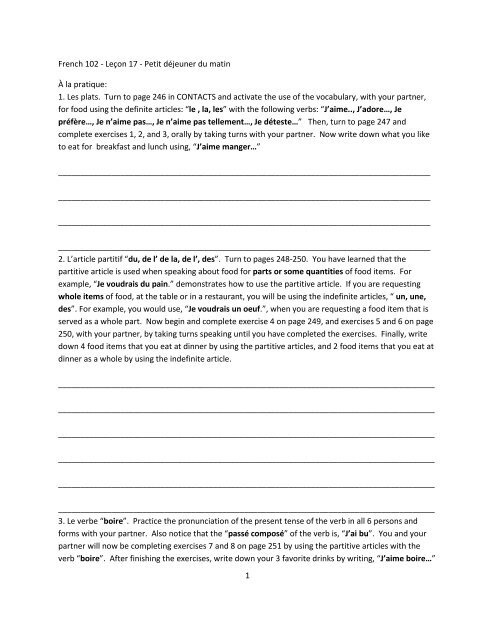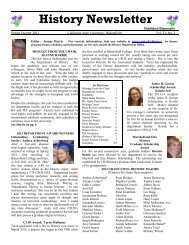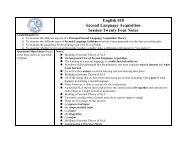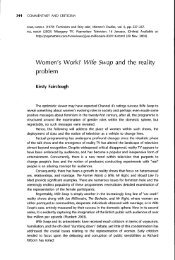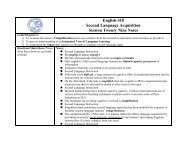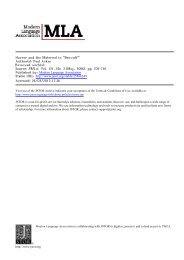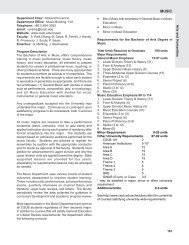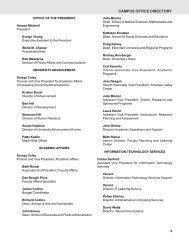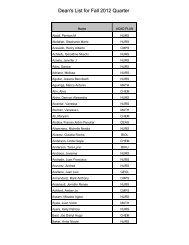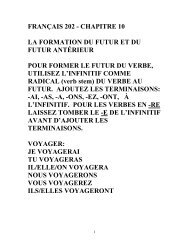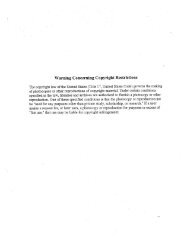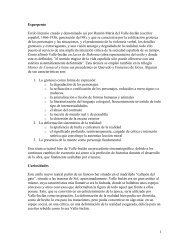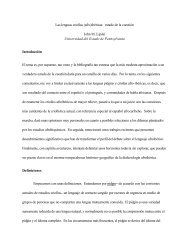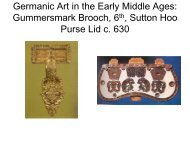1 French 102 - Leçon 17 - Petit déjeuner du matin À la pratique: 1 ...
1 French 102 - Leçon 17 - Petit déjeuner du matin À la pratique: 1 ...
1 French 102 - Leçon 17 - Petit déjeuner du matin À la pratique: 1 ...
You also want an ePaper? Increase the reach of your titles
YUMPU automatically turns print PDFs into web optimized ePapers that Google loves.
<strong>French</strong> <strong>102</strong> - <strong>Leçon</strong> <strong>17</strong> - <strong>Petit</strong> <strong>déjeuner</strong> <strong>du</strong> <strong>matin</strong><br />
<strong>À</strong> <strong>la</strong> <strong>pratique</strong>:<br />
1. Les p<strong>la</strong>ts. Turn to page 246 in CONTACTS and activate the use of the vocabu<strong>la</strong>ry, with your partner,<br />
for food using the definite articles: “le , <strong>la</strong>, les” with the following verbs: “J’aime.., J’adore…, Je<br />
préfère…, Je n’aime pas…, Je n’aime pas tellement…, Je déteste…” Then, turn to page 247 and<br />
complete exercises 1, 2, and 3, orally by taking turns with your partner. Now write down what you like<br />
to eat for breakfast and lunch using, “J’aime manger…”<br />
____________________________________________________________________________________<br />
____________________________________________________________________________________<br />
____________________________________________________________________________________<br />
____________________________________________________________________________________<br />
2. L’article partitif “<strong>du</strong>, de l’ de <strong>la</strong>, de l’, des”. Turn to pages 248-250. You have learned that the<br />
partitive article is used when speaking about food for parts or some quantities of food items. For<br />
example, “Je voudrais <strong>du</strong> pain.” demonstrates how to use the partitive article. If you are requesting<br />
whole items of food, at the table or in a restaurant, you will be using the indefinite articles, “ un, une,<br />
des”. For example, you would use, “Je voudrais un oeuf.”, when you are requesting a food item that is<br />
served as a whole part. Now begin and complete exercise 4 on page 249, and exercises 5 and 6 on page<br />
250, with your partner, by taking turns speaking until you have completed the exercises. Finally, write<br />
down 4 food items that you eat at dinner by using the partitive articles, and 2 food items that you eat at<br />
dinner as a whole by using the indefinite article.<br />
_____________________________________________________________________________________<br />
_____________________________________________________________________________________<br />
_____________________________________________________________________________________<br />
_____________________________________________________________________________________<br />
_____________________________________________________________________________________<br />
_____________________________________________________________________________________<br />
3. Le verbe “boire”. Practice the pronunciation of the present tense of the verb in all 6 persons and<br />
forms with your partner. Also notice that the “passé composé” of the verb is, “J’ai bu”. You and your<br />
partner will now be completing exercises 7 and 8 on page 251 by using the partitive articles with the<br />
verb “boire”. After finishing the exercises, write down your 3 favorite drinks by writing, “J’aime boire…”<br />
1
with the partitive articles.<br />
_____________________________________________________________________________________<br />
_____________________________________________________________________________________<br />
_____________________________________________________________________________________<br />
4. L’article partitif au négatif. Turn to pages 253-254 to begin the exercises 10, 11 and 12, which require<br />
the use of “ne…pas de” to negate the partitive articles, “<strong>du</strong> (de l’), de <strong>la</strong> (de l’), des”. Please notice in<br />
the middle of page 253, that “ne… pas de” is never used with the verb “être”, but rather, the partitive<br />
articles are to be used instead. Now begin the exercises by taking turns with your partner. After you<br />
have finished the exercises, please write 3 sentences about food or drinks that you never eat or drink.<br />
____________________________________________________________________________________<br />
_____________________________________________________________________________________<br />
_____________________________________________________________________________________<br />
5. L’emploi idiomatique de “faire”. You have already learned and practiced using the verb “faire” in a<br />
previous lesson. Review the present tense of the verb here: “je fais, tu fais, il/elle fait, nous faisons,<br />
vous faites, ils/elles font”. (Do not forget that the passé composé of “faire” is “j’ai fait”.) Now<br />
complete exercise 9 on page 252 with your partner. Afterwards, please ask your partner 3 questions,<br />
and vice versa, with the inverted verb format (Fais-tu…?), then write down your partner’s 3 answers and<br />
your partner will do the same with your answers.<br />
_____________________________________________________________________________________<br />
_____________________________________________________________________________________<br />
_____________________________________________________________________________________<br />
2


